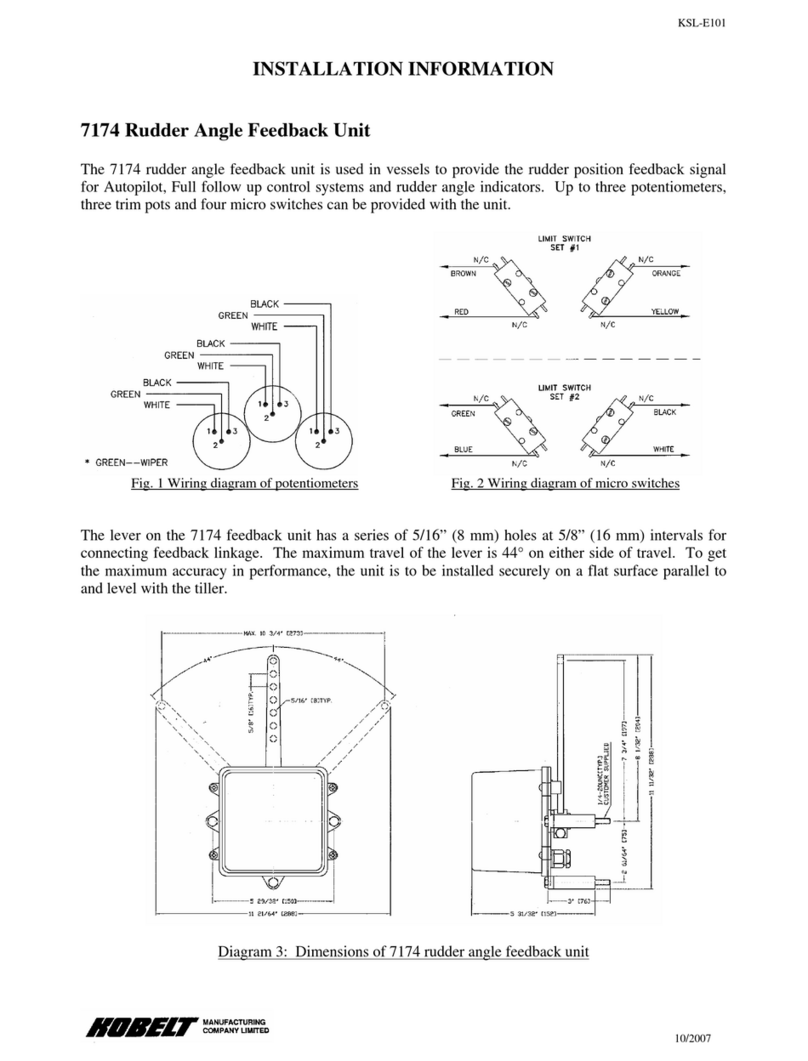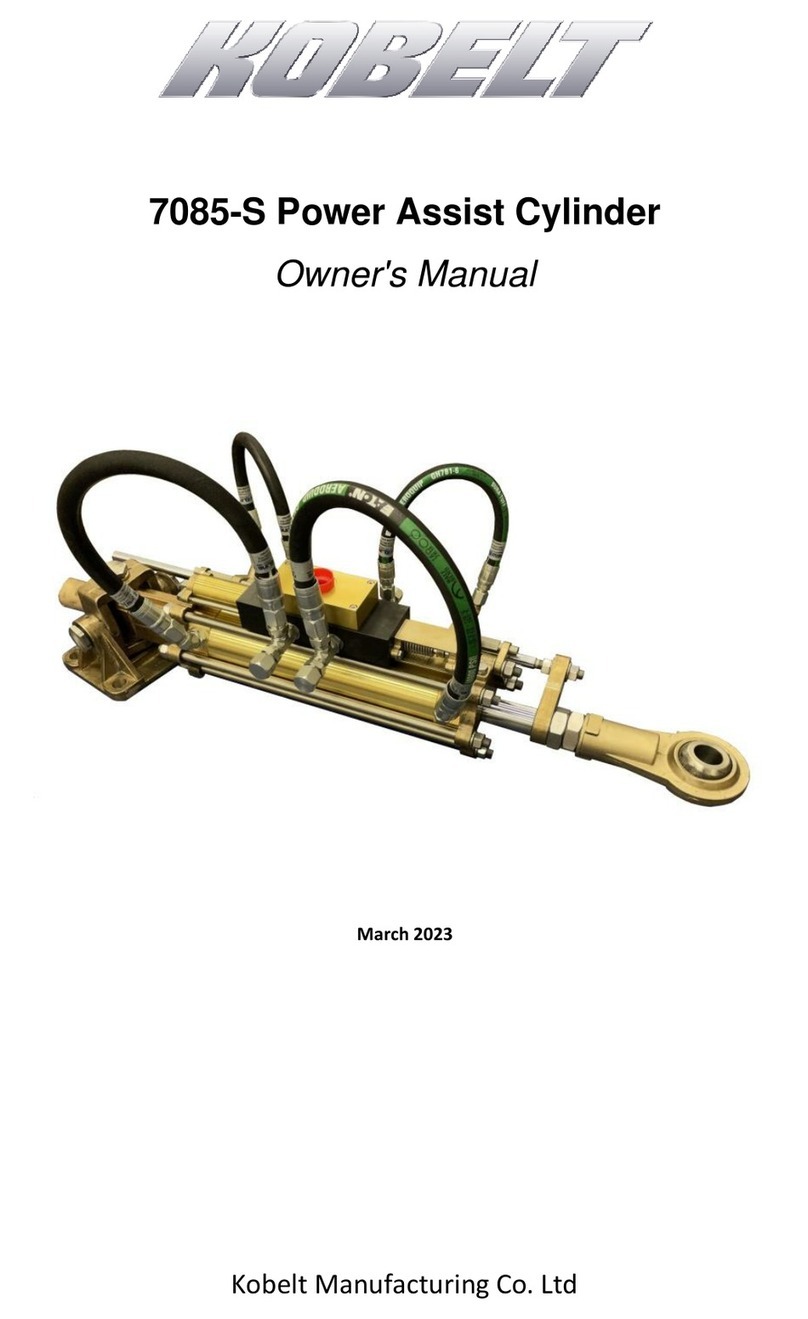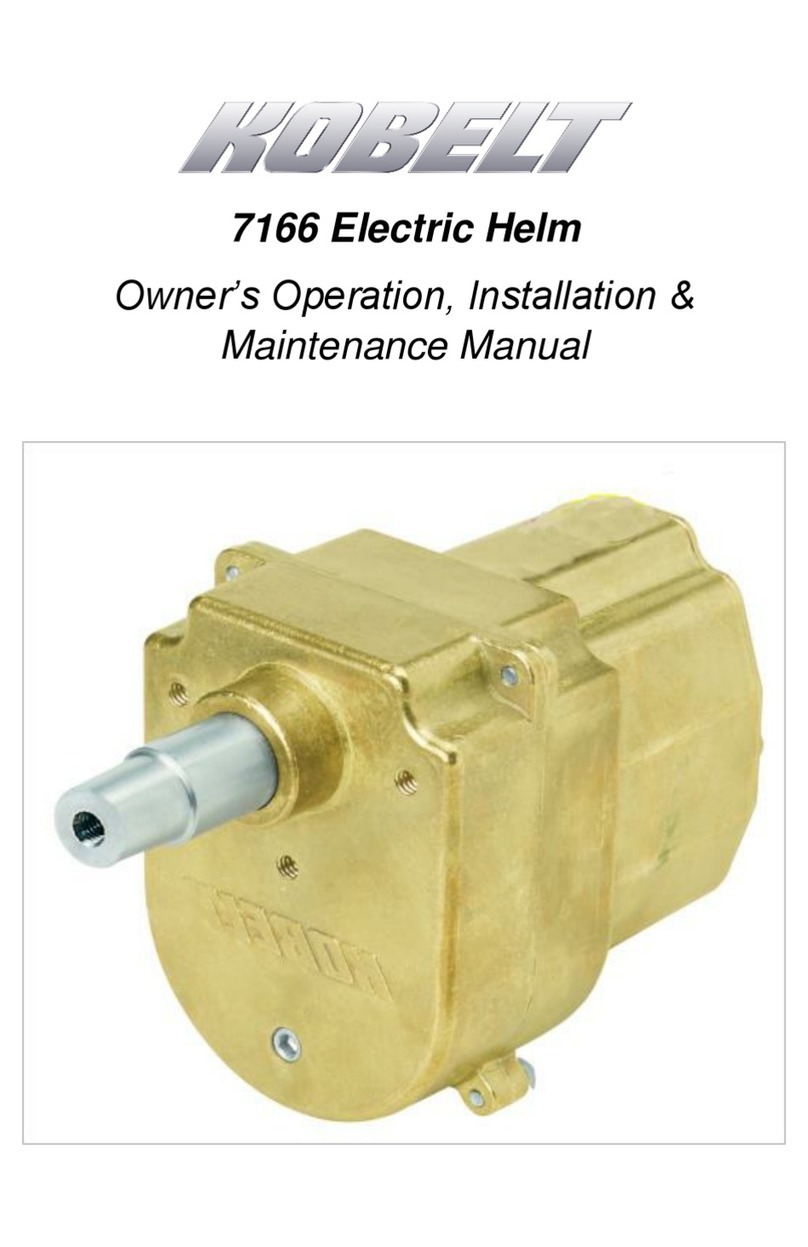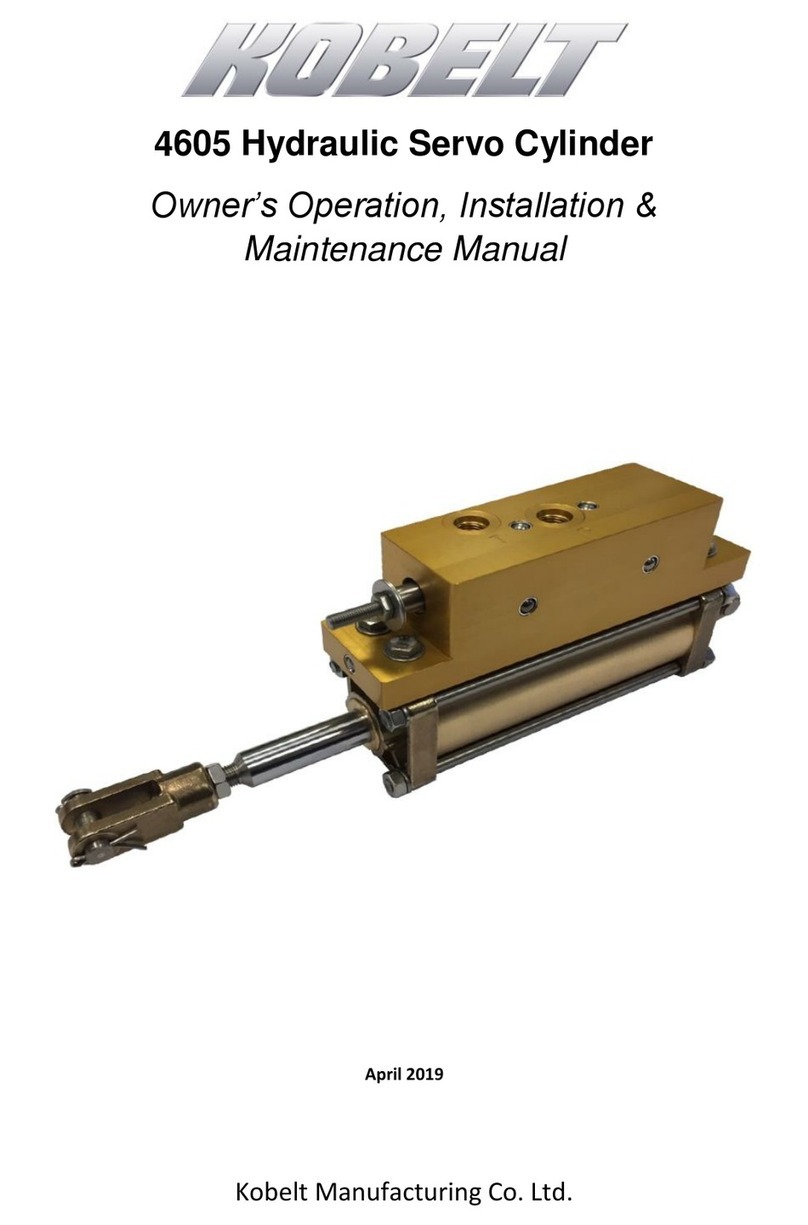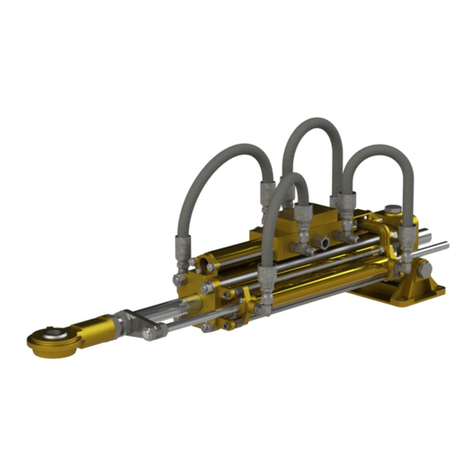Kobelt 5020-M Series Instruction Manual

Kobelt Manufacturing Co. Ltd.
5020-M Series Disk Brakes
Manually Applied Version
Owner’s Operation, Installation &
Maintenance Manual

5020-M Owner's Manual Kobelt Manufacturing Co. Ltd.
rev B mnl5020-M.docx 2 of 27
NOTES:
RECORD DATA BEFORE INSTALLATION FOR FUTURE REFERENCE
Model #:
Serial #:
Date of Purchase:
Date of Installation:

5020-M Owner's Manual Kobelt Manufacturing Co. Ltd.
rev B mnl5020-M.docx 3 of 27
TABLE OF CONTENTS
1Introduction .......................................................................................................... 4
1.1 Contact .......................................................................................................................4
1.2 Safety..........................................................................................................................4
2Product Description ............................................................................................... 7
2.1 Technical Data ............................................................................................................7
3Installation.......................................................................................................... 10
3.1 Preparation...............................................................................................................10
3.2 Brake Discs................................................................................................................10
3.3 Caliper Brakes...........................................................................................................12
4Commissioning .................................................................................................... 13
4.1 Air Gap......................................................................................................................13
4.2 Function Test............................................................................................................13
4.3 Burnishing.................................................................................................................13
4.4 Torque Test...............................................................................................................14
5Operation............................................................................................................ 15
5.1 Service Limits............................................................................................................15
5.2 Manual Operation ....................................................................................................16
6Maintenance ....................................................................................................... 17
6.1 Preventative Maintenance.......................................................................................17
6.2 Inspection.................................................................................................................17
6.3 Service ......................................................................................................................18
6.4 Recommended Spare Parts......................................................................................20
7Troubleshooting .................................................................................................. 21
8Warranty............................................................................................................. 22
9Appendix A: Technical Drawings........................................................................... 23
10 Appendix B: Parts List Drawings ........................................................................... 24

5020-M Owner's Manual Kobelt Manufacturing Co. Ltd.
rev B mnl5020-M.docx 4 of 27
1INTRODUCTION
1.1 CONTACT
Kobelt Manufacturing Co. Ltd.
8238 129th Street
Surrey, British Columbia
Canada, V3W 0A6
Sales Tel:
Fax:
Email:
Website:
This document is intended to clearly present comprehensive product data and provide
technical information to assist the end user in design applications. Kobelt reserves the right,
without notice, to change the design, or construction, of any products and to discontinue or
limit distribution of any products. Kobelt also reserves the right to change, or update, without
notice, any technical information contained within this document.
Kobelt recommends that customers visit our website to check for updates to this Manual.
Once a product has been selected for use, it should be tested by the user to ensure proper
function in all possible applications. For further instructions, please contact our distributors or
visit our website.
1.2 SAFETY
1.2.1 Safety Alerts
Throughout this manual, the following symbols, and their accompanying explanation, are
used to alert the user to special instructions concerning a service or operation that may be
hazardous if performed incorrectly or carelessly. The associated risk levels are stated below.
This symbol indicates an imminently hazardous situation which, if
not avoided, will result in death or serious injury.
This symbol indicates a potentially hazardous situation which, if not
avoided, could result in death or serious injury.
This symbol indicates a hazardous situation, which if not avoided,
could result in minor or moderate injury.
This symbol informs the reader of events not related to personal
injury but which there is a risk of damage to property or equipment.
This symbol informs the reader of safety-related instructions or
procedures.

5020-M Owner's Manual Kobelt Manufacturing Co. Ltd.
rev B mnl5020-M.docx 5 of 27
1.2.2 Notice to Installer
Disregarding the following safety measures can result in an accident causing severe injury to
personnel and damage to material assets.
•Only use the product as directed in this manual.
•Never put the product into service if there is evidence of visible damage.
•Never put the product into service before fully completing installation and
commissioning.
•Do not carry out any modifications to the product.
•Only use authentic Kobelt spare parts.
•Observe all local regulations, directives and laws during the installation of this product.
•All installation, commissioning, and maintenance work must only be conducted by
qualified personnel. (For the purpose of this manual, qualified personnel are persons
who are familiar with the assembly, installation, commissioning, and operation of the
product and who have the qualifications necessary for their occupation.)
•Observe all specifications in this manual. If these guidelines are not followed and
damage occurs, the warranty will be voided.

5020-M Owner's Manual Kobelt Manufacturing Co. Ltd.
rev B mnl5020-M.docx 6 of 27
1.2.3 Product Hazards
Equipment Starts Automatically: Brake systems frequently are
controlled remotely and may activate suddenly causing bodily harm.
Ensure all power sources are locked out prior to performing work.
Pinch Points: Brakes contain numerous pinch points which can
cause serious injury. Ensure all power sources are locked out prior
to performing work.
Hot Surfaces: Disc brakes are capable of making the surfaces of the
brake disc dangerously hot when burnishing or during braking
events. Ensure the disc is adequately guarded to prevent
inadvertent contact with the disc.
Airborne Dust: Brake linings contain fibers that may become
airborne during cutting or sanding operations. Over exposure to
these dusts should be considered hazardous. Use NIOSH approved
respirators when working with brake linings. Request a MSDS for
further information.

5020-M Owner's Manual Kobelt Manufacturing Co. Ltd.
rev B mnl5020-M.docx 7 of 27
2PRODUCT DESCRIPTION
The diagram below shows a typical Kobelt caliper brake with all the major components
identified.
Figure 1: Caliper Brake Nomenclature
2.1 TECHNICAL DATA
BRAKE SPECIFICATIONS
Normal Force1: 0 …4550 lbs [20.2 KN]
Temperature Range: -55oF …+120oF [-48oC …+49oC]
Disc Thickness: 1¼ in [32 mm]
Minimum Disc Diameter: 12 in [229 mm]
Maximum Disc Diameter: unlimited2
Weight: 33 lbs [14.8 kg]
SWITCH SPECIFICATIONS
Type: inductive sensor (PNP)
Output: normally open
Voltage: 10…30 VDC
Current consumption: 15 mA
Switching output: 200 mA
Switching frequency: 800 hz
Temperature Range: -13oF …+120oF [-25oC …+49oC]
Protection: IP65

5020-M Owner's Manual Kobelt Manufacturing Co. Ltd.
rev B mnl5020-M.docx 8 of 27
1) Values in this chart are theoretical and for reference only. They are based on properly
bedded and burnished linings acting on a rotor at 20oC and manufactured to required
specifications.
2) Requires a minimum 2.80 in [71 mm] wide face
For further technical data and specifications refer to the relevant datasheets from
www.kobelt.com or the technical drawings in Appendix A if provided.
0
500
1000
1500
2000
2500
3000
3500
4000
4500
12 15 18 21 24 27 30 33 36
Braking Torque (ft-lbf)
Disc OD (in)
5020-M
BRAKING TORQUE1

5020-M Owner's Manual Kobelt Manufacturing Co. Ltd.
rev B mnl5020-M.docx 9 of 27
2.2 MODEL CODE KEY

5020-M Owner's Manual Kobelt Manufacturing Co. Ltd.
rev B mnl5020-M.docx 10 of 27
3INSTALLATION
3.1 PREPARATION
The foundation plate to support the brake caliper must be designed to withstand the
maximum braking forces generated by the brake caliper. The foundation must also be flat to
ISO tolerance grade IT8 and square to the brake disc. See Appendix A for key installation
dimensions. The brake pedestal must be designed to allow the mounting bolts to be inserted
from underneath.
The rotating element should have bearings sufficient to carry the weight of the disc and also
resist the additional stress when the disc brake is applied.
The spigot that centers the brake disc must not be designed in such a way that it impedes the
thermal expansion of the disc.
Brake discs are shipped with a light rust inhibitor applied to the surfaces. Remove the rust
inhibitor using solvent and a cloth prior to installation.
Any guarding around the brakes must provide enough room to allow full extension of the
bake actuators plus full pad wear adjustment.
3.2 BRAKE DISCS
The brake disc must be installed onto the rotating element before installing the caliper. Brake
discs must meet the following requirements:
Table 1: Brake Disc Requirements
PARAMETER
VALUE
AXIAL RUN OUT
IT9 (TIR)①
RADIAL RUN OUT
IT11 (TIR) ①
FLATNESS
.003 in [0.08 mm] ②
PILOT FIT
H9/f8
SURFACE FINISH
63 micro inches [1.6 micrometers] RMS
SURFACE HARDNESS
HB135 minimum
To achieve the run-out tolerance the mounting face on the rotating element must be
machined flat. Excessive run-out of the disc could cause premature wear of the linings, caliper
pins, lever journals as well as the actuators.
①
International tolerance class. Allowable run out is proportional disc O.D.
②
Per 2.5 in [64 mm] square area

5020-M Owner's Manual Kobelt Manufacturing Co. Ltd.
rev B mnl5020-M.docx 11 of 27
The disc mounting bolts used must be of a suitable size and grade to safely resist the brake
torque plus the stresses induced from thermal expansion of the disc. For high temperature
disc applications, the holes for the mounting bolts must be machined oversized to allow the
disc to expand during operation. Ensure that adequate washers are used to bridge the gap
between the bolt and bolt hole.
Table 2: Mounting Bolt Radial Clearance
MOUNTING BOLT RADIAL CLEARANCE
Disc Bolt Circle
In [mm]
Maximum Disc Temperature, °F [°C]
400 [204]
500 [260]
600 [316]
700 [371]
10 [254]
0.011 [0.3]
0.014 [0.4]
0.017 [0.4]
0.021 [0.5]
15 [381]
0.016 [0.4]
0.021 [0.5]
0.026 [0.7]
0.031 [0.8]
20 [508]
0.022 [0.6]
0.028 [0.7]
0.035 [0.9]
0.041 [1.0]
25 [635]
0.027 [0.7]
0.035 [0.9]
0.043 [1.1]
0.051 [1.3]
30 [762]
0.032 [0.8]
0.042 [1.1]
0.052 [1.3]
0.062 [1.5]
35 [889]
0.038 [1.0]
0.049 [1.2]
0.061 [1.5]
0.072 [1.8]
40 [1016]
0.043 [1.1]
0.056 [1.4]
0.069 [1.8]
0.082 [2.1]
To reduce the size of the mounting bolt clearance hole it is recommended to offset the bolt
circle on the brake disc inwards the required amount for radial clearance. The end result is
the brake disc will have a slightly smaller bolt circle than the hub and the required radial
clearance will be on the side where it is needed.
Do not use fitted bolts for installing brake discs. The bolt holes must
be over sized to permit uninhibited expansion.
Do not secure a brake disc to a rotating element by welding.
Do not paint the cooling fins of a ventilated disc. The cooling
efficiency will be compromised, and overheating may result.
If the disc was damaged during installation with nicks or welding marks, remove the defects
before putting into service.
For cases where a disc guard or some protective cover is required for a ventilated disc ensure
that the guard does not compromise the performance. An improperly designed cover or
shield may cause air recirculation through the disc or radiant heat reflection, which could
result in the disc overheating. The cooling air pumped through the disc must be exhausted
away from the outer diameter of the disc to allow fresh, cool air to enter the inner vent
opening of the disc.

5020-M Owner's Manual Kobelt Manufacturing Co. Ltd.
rev B mnl5020-M.docx 12 of 27
3.3 CALIPER BRAKES
3.3.1 Mechanical
Perform the following steps to properly install a caliper brake:
1. Lower the brake onto the brake pedestal and center over the mounting holes.
2. Using feeler gauges to ensure that the brake air gap is equal on both sides of the disc.
Ensure the caliper is centered. The balancing link will be subjected
to excessive stresses that will damage it.
3. Position the brake so that the outer radius of the brake shoe is in full contact with the
Disc. Do not move the brake too close as enough radial distance must be provided to
allow for disc expansion without causing interference between the outer circumference
of the disc and the inner caliper frame.
4. Manually apply the brake onto the disc. The brake shoes will naturally align with the
disc.
5. Probe under the brake base with feeler gauges to determine the shimming requirement.
6. Manually release the brake again and lift the brake up approximately two inches.
7. Insert the shims determined from step 6. Use ANSI shims that straddle the mounting
bolts.
8. Insert the mounting bolts from underneath the pedestal using appropriate flat washers.
The nut must be on top of the brake foot. The mounting bolts must be of SAE grade 5 or
better. It is recommended to use a thread locking product such as Loctite® to ensure a
vibration resistant and secure joint.
9. Lower the brake down and tighten the mounting bolts to the recommended preload.
3.3.2 Instrumentation
Kobelt caliper disc brakes may be equipped
with a release indicating proximity switch (part
number 6001-3711). The connection to the
switch must be made with a 3 pin –M8 cable.
Figure 2: Connection Diagram

5020-M Owner's Manual Kobelt Manufacturing Co. Ltd.
rev B mnl5020-M.docx 13 of 27
4COMMISSIONING
4.1 AIR GAP
The running clearance between the pads and disc is factory set and not adjustable. As a
check prior to putting the brakes into service, ensure that the airgap between the brake pads
and disc when the brakes are released is at least 0.01” [0.25 mm] per shoe.
If the pads have worn excessively (0.25 inches [6.4 mm] or more per side), the shoes can be
shimmed with a 5020-0750 shim kit.
4.2 FUNCTION TEST
Before burnishing the brakes perform a quick inspection and function test of the brakes:
1. Ensure that all mounting bolts are properly installed.
2. Ensure proper running clearance (air gap) with the disc.
3. Ensure unobstructed movement of the brake levers for full actuator extension.
4. Ensure the brake disc surface is clean. Remove all contamination from the disc with
cleaning solvent.
5. Check that all bolts are tight and cotter pins are in place.
6. Cycle the brakes and ensure that the brakes are operational (reference section 5.2 for
operating the brake).
4.3 BURNISHING
Burnishing is required in order to achieve rated brake torque. The process of burnishing
removes minor contaminants from the rubbing surfaces and improves the degree of contact
between the brake pad and disc.
Before burnishing, the brake disc must be checked to ensure it is free from contamination
and oil. Use a solvent and cloth to remove any oil residue. Slight surface rust will be removed
during the burnishing process, but heavy rust should be removed prior to burnishing.
If present, safety interlocks of the drive mechanism should be temporarily defeated to allow
the disc to be driven with the brake partially applied.
The temperature of the disc surface must be monitored during the burnishing process and
kept between 250oF (120oC) and 500oF (260oC). If the upper temperature is reached, pause
the burnishing process until the disc is cooled to the lower limit.
Extreme care must be taken not to overheat the disc during the process. On water cooled
discs it may be necessary to limit the flow of cooling water in order to achieve the necessary
disc temperature for effective burnishing.

5020-M Owner's Manual Kobelt Manufacturing Co. Ltd.
rev B mnl5020-M.docx 14 of 27
Reference section 5.2 for instructions on manually operating the brake.
Disc temperature must not exceed 700°F (371°C) or permanent
degradation of the lining may occur.
Burnishing is best achieved by applying the maximum torque and minimum speed that the
drive can tolerate. Depending on the configuration of the brake system it may be necessary to
reduce the burnishing torque by:
•Partially applying the brake to a level that the drive can tolerate, or
•In systems with more than one brake, isolate all but one brake and burnish one brake at
a time.
Three important points to consider when burnishing are:
1. The temperature of the disc must be closely monitored. Excessive heat will damage the
friction linings.
2. The duration of burnishing varies with each application.
3. Burnishing is not complete until the brake is producing rated torque. This will be
indicated by the motor current while burnishing.
Failure to properly burnish will not allow the brake to produce
adequate torque for the intended duty.
4.4 TORQUE TEST
Before putting equipment into service, confirm that full rated braking torque has been
achieved through load testing or a torque test against the drive motors. If full brake torque
has not been achieved, continue burnishing.
Reference section 5.2 for setting brake torque.

5020-M Owner's Manual Kobelt Manufacturing Co. Ltd.
rev B mnl5020-M.docx 15 of 27
5OPERATION
5.1 SERVICE LIMITS
5.1.1 Disc Temperature
The Kobelt brake lining achieves maximum friction at 300°F. Over 300°F the brake begins to
fade or experience diminishing friction. The maximum operating temperature of the brake
linings is 700°F [371°C]. Temperatures in excess of this limit will permanently damage the
linings and require replacement.
5.1.2 Ambient Temperature
In sub-zero temperatures ventilated discs must be warmed up gently to avoid causing
excessive thermal stresses in the disc. Failure to do so could cause the disc to crack. Once the
temperature of the disc is out of freezing condition it can be used as normally intended.
Operating temperature of standard brake actuators is -40°C [-40°F] to 120°C [248°F]
5.1.3 Disc speed
The potential imbalance in the ventilated disc could be detrimental to rotating equipment at
high speeds. For running speeds greater than the values listed in the table below the discs
must be balanced. Under no circumstances must the running speed exceed the value given in
the right-hand column.
Table 3: Maximum Disc Speeds
Part Number
Nominal OD
inch mm
Max. Speed
rpm
1.25” x 2.5” Series
Standard
Balanced
1.25-2.5-12
12
307
2140
4600
1.25-2.5-15
15
385
1610
3650
1.25-2.5-18
18
457
1290
3000
1.25-2.5-21
21
536
1090
2550
1.25-2.5-24
24
612
940
2250
1.25-2.5-27
27
688
820
1980
1.25-2.5-30
30
762
730
1780

5020-M Owner's Manual Kobelt Manufacturing Co. Ltd.
rev B mnl5020-M.docx 16 of 27
5.2 MANUAL OPERATION
To apply the brake, turn the handwheel clockwise until the pads contact the disc. Then, using
a torque wrench acting on the torque setting nut and the chart below as a reference, set the
desired brake torque by applying the correct amount or torque to the handwheel..
1) Values in this chart are theoretical and for reference only. They are based on properly
bedded and burnished linings acting on a rotor at 20oC and manufactured to required
specifications.
For example:
To generate 2000 ft-lbs of
torque in order to safely lock a
fan against drafts;
1. Look up the desired
torque level on the
vertical axis of the chart
2. Locate the disc size on
the horizontal axis of the
chart
3. Read the required input
torque from where the
two lines intersect.
0
500
1000
1500
2000
2500
3000
3500
4000
4500
12 15 18 21 24 27 30 33 36
Braking Torque (ft-lbf)
Disc OD (in)
5020-M
BRAKING TORQUE1

5020-M Owner's Manual Kobelt Manufacturing Co. Ltd.
rev B mnl5020-M.docx 17 of 27
6MAINTENANCE
6.1 PREVENTATIVE MAINTENANCE
•Monthly (12 times per year)
oMeasure air gap
oDetermine pad life
•Annually (1 time per year)
oLubricate pivot pins
oInspect brake disc
oTorque Test
•Every 5 years
oInspect brake pins
6.2 INSPECTION
6.2.1 Pad Wear
The running clearance (air gap) between lining and disc must be maintained within the
specified limits. Failure to do so will result in sluggish brake response and excessive air
consumption. When the running clearance has reached 0.04” [1 mm] the brake must be
adjusted back to 0.01” [0.25 mm] per shoe. Refer to section 5.3.2.
For pressure applied brakes maintain the proper running clearance between the shoe and the
disc to ensure fast response and minimize the air consumption.
The maximum allowable pad life has been reached when the brake pad has worn down to
3/16” [4.8 mm] thick. The lining must be replaced before the shoe lining bolts or rivets start
making contact with the brake disc.
6.2.2 Pin Wear
The pivot pins must be removed for inspection once every five years. If there is any evidence
of heavy scoring more than 0.01” [0.25 mm] deep or if any area of the pin has been worn
down by more than 0.01” [0.25 mm] then replace the pins.
6.2.3 Brake Disc
The brake disc must be inspected periodically to monitor the condition of the braking surface.
When the condition of the braking surface has deteriorated to the point that the quality
requirements in section 3.2 are no longer met the disc must be removed and resurfaced or
replaced. Follow the minimum thickness allowances in the table below as a guideline for
when a disc must be replaced.

5020-M Owner's Manual Kobelt Manufacturing Co. Ltd.
rev B mnl5020-M.docx 18 of 27
Table 4: Brake Disc Minimum Thickness Allowances
Brake Disc Minimum Thickness
Disc Series
Original Thickness
in [mm]
Minimum Thickness
in [mm]
1.25-2.5-XX
1.25 [31.8]
1.18 [30.0]
When re-machining the disc surface, equal amounts must be taken
off of each face.
6.3 SERVICE
6.3.1 Lubrication
All Kobelt calipers, during assembly, are pre-greased on the shoe pin and saddle pin with a
Lithium based NLGI 2 grease. These pins must be re-greased no less than once annually.
6.3.2 Brake Linings
The linings must be replaced before the rivets make contact with the disc. Remove worn
linings from the shoe by drilling out the rivets with a ¼” drill. Install new linings with the
proper rivets.
6.3.2.1 Lining Replacement
Figure 3: Lining Replacement Reference Diagram
Follow the following steps to replace the lining:

5020-M Owner's Manual Kobelt Manufacturing Co. Ltd.
rev B mnl5020-M.docx 19 of 27
1. Remove bottom cotter pins from pins ‘E’.
2. Remove pins ‘E’ by pulling upwards.
3. Remove shoes by sliding radially forward to clear the ends of the levers.
When re-installing the shoes into the caliper assembly, be sure to re-engage the balancing
links “A”
If there is insufficient room radially to remove the shoe, then screws ‘C’ must be removed.
6.3.2.2 Balancing Link Adjustment
Figure 4: Balancing Link Adjustment Reference Diagram
To adjust:
1. Loosen screws ‘B’,
2. Apply brakes onto the disc,
3. Ensure link ‘A’ has no tension on it. Adjust if necessary.
6.3.2.3 Reinstalling the Shoes and Pivot Blocks
When reinstalling the shoes and pivot blocks reinstall the shoe pin first to align the pivot
blocks before tightening screws ‘C’. Tighten screws ‘C’ to the value given in the table below.
Table 5: Pivot Block Screw Torque
Caliper Model
Bolt Size
Torque
5020
3/8 UNC
201 in-lbs [22.7 Nm]

5020-M Owner's Manual Kobelt Manufacturing Co. Ltd.
rev B mnl5020-M.docx 20 of 27
6.4 RECOMMENDED SPARE PARTS
The spare parts kept on hand will depend on the severity of the service. As a minimum Kobelt
recommends keeping the following parts for each brake in service:
1. One Lined set of brake shoes
2. One set of brake pads with rivets
When purchasing replacement parts refer to Appendix B: Parts List at the back of this manual
for Kobelt component Part Numbers.
It is recommended that any required service work on a Kobelt unit
be performed by a factory authorized service representative. Please
contact the nearest Kobelt authorized distributor for assistance.
The table below itemizes which kit/spare part numbers change with the various brake
configuration options. Please reference this table to ensure you receive the correct parts.
Table 6: Configuration Kit Numbers
Configuration Kit Numbers
Disc Code
Shim Kit
Disc Thickness
-100
5026-3500
3.500 in
-075
5026-3000
3.000 in
-050
5026-2500
2.500 in
Friction Code
Lined Shoe
Friction Material
-N
5020-LSN
non-sparking
-C
5020-LSC
low COF (.12-.15)
-E
5020-LSE
mid COF (.25-.28)
Table of contents
Other Kobelt Industrial Equipment manuals
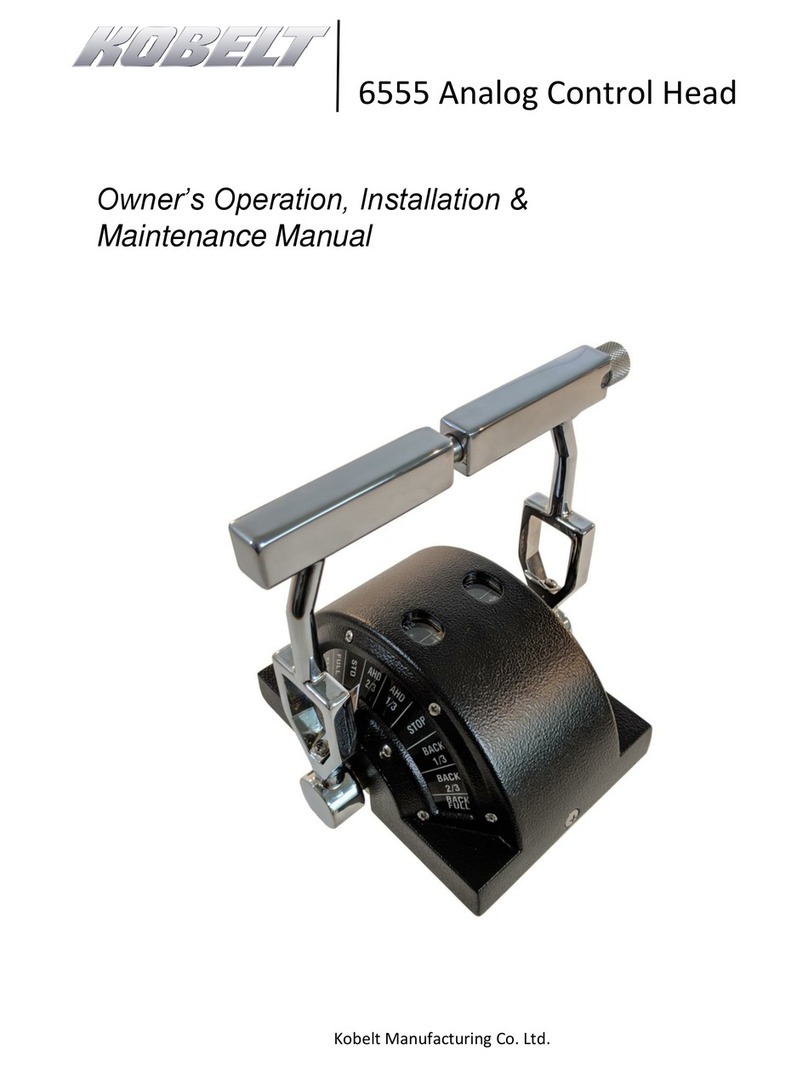
Kobelt
Kobelt 6555 User manual
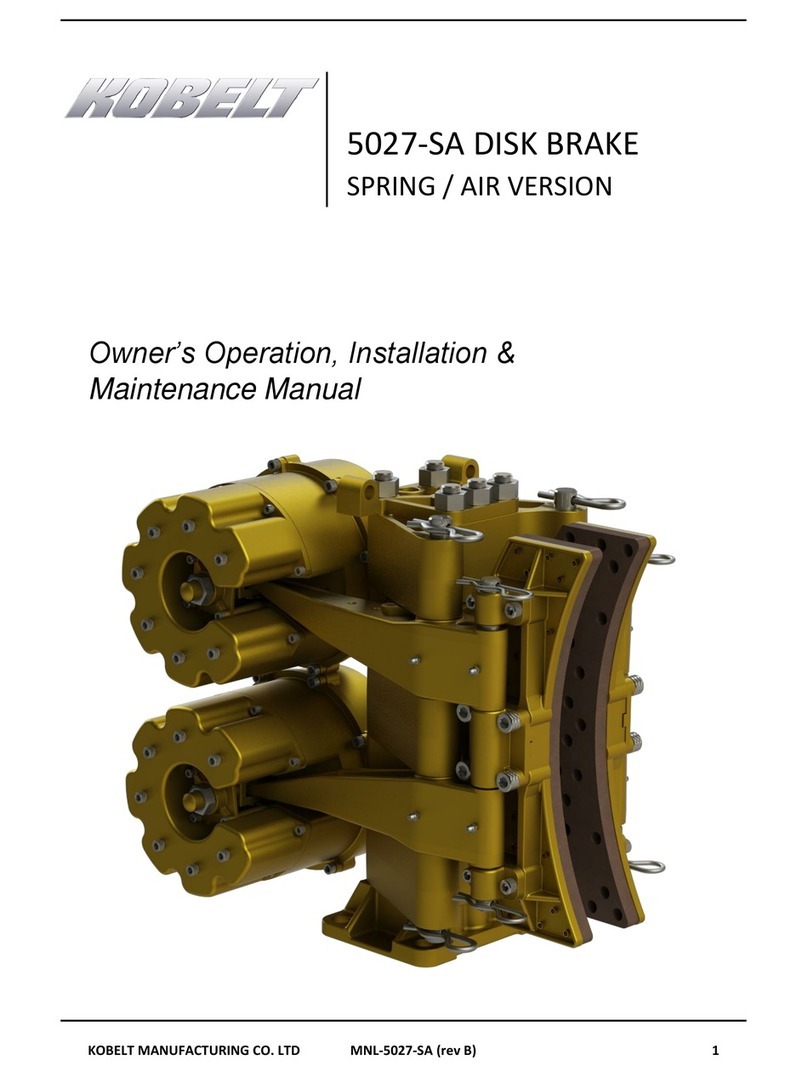
Kobelt
Kobelt 5027-SA User manual
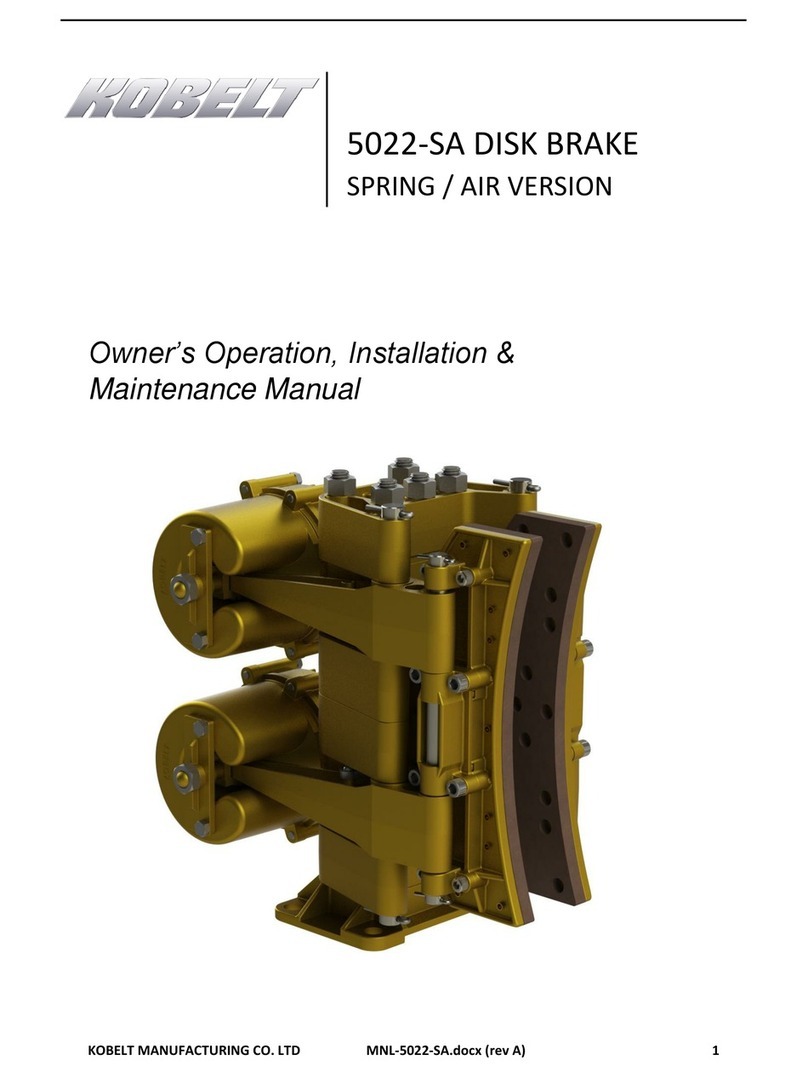
Kobelt
Kobelt 5022-SA Instruction Manual
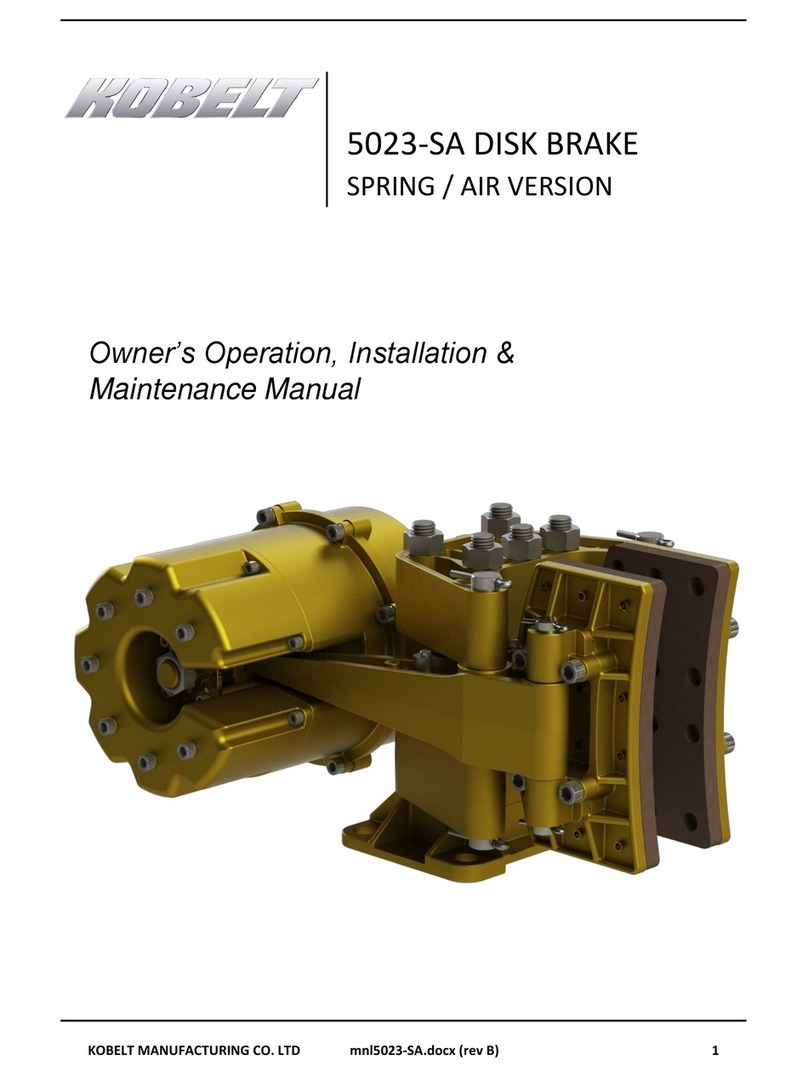
Kobelt
Kobelt 5023-SA Instruction Manual
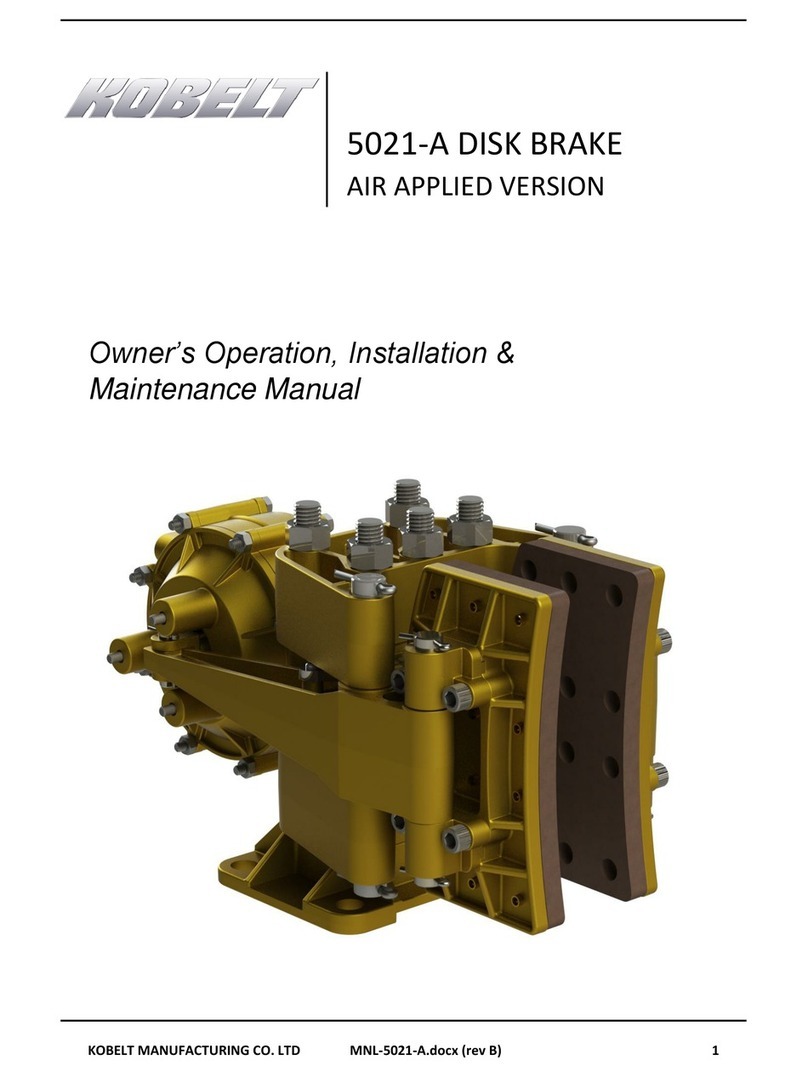
Kobelt
Kobelt 5021-A Instruction Manual
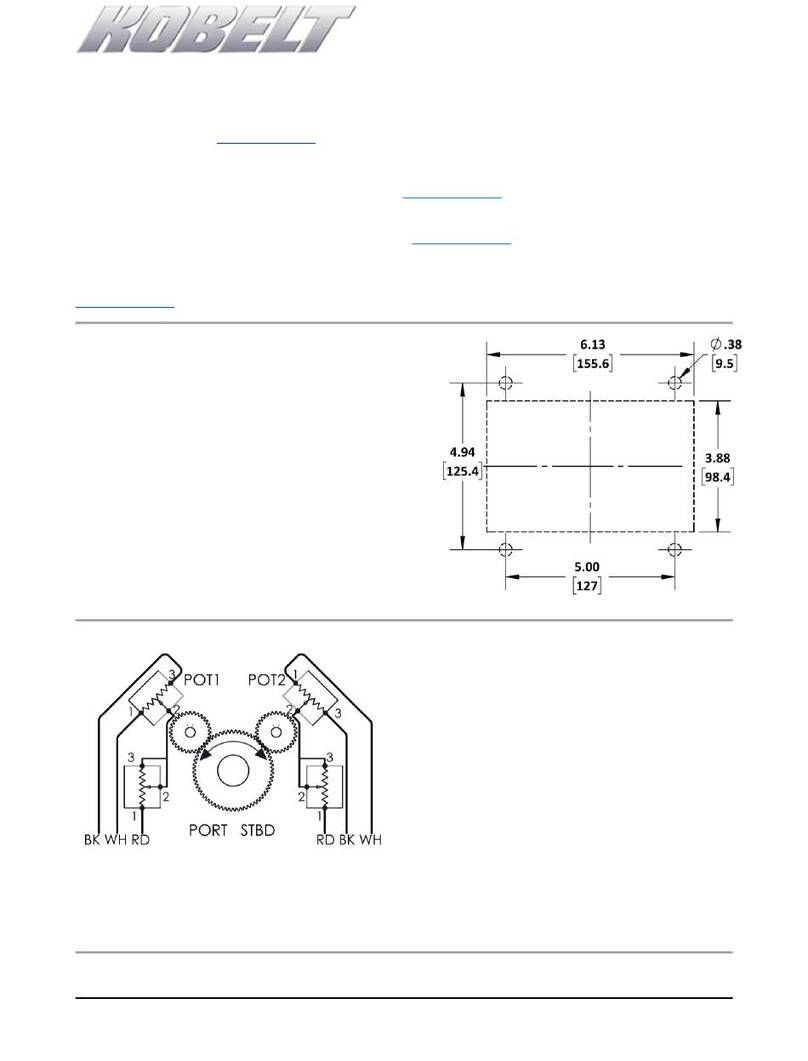
Kobelt
Kobelt 7172 User manual
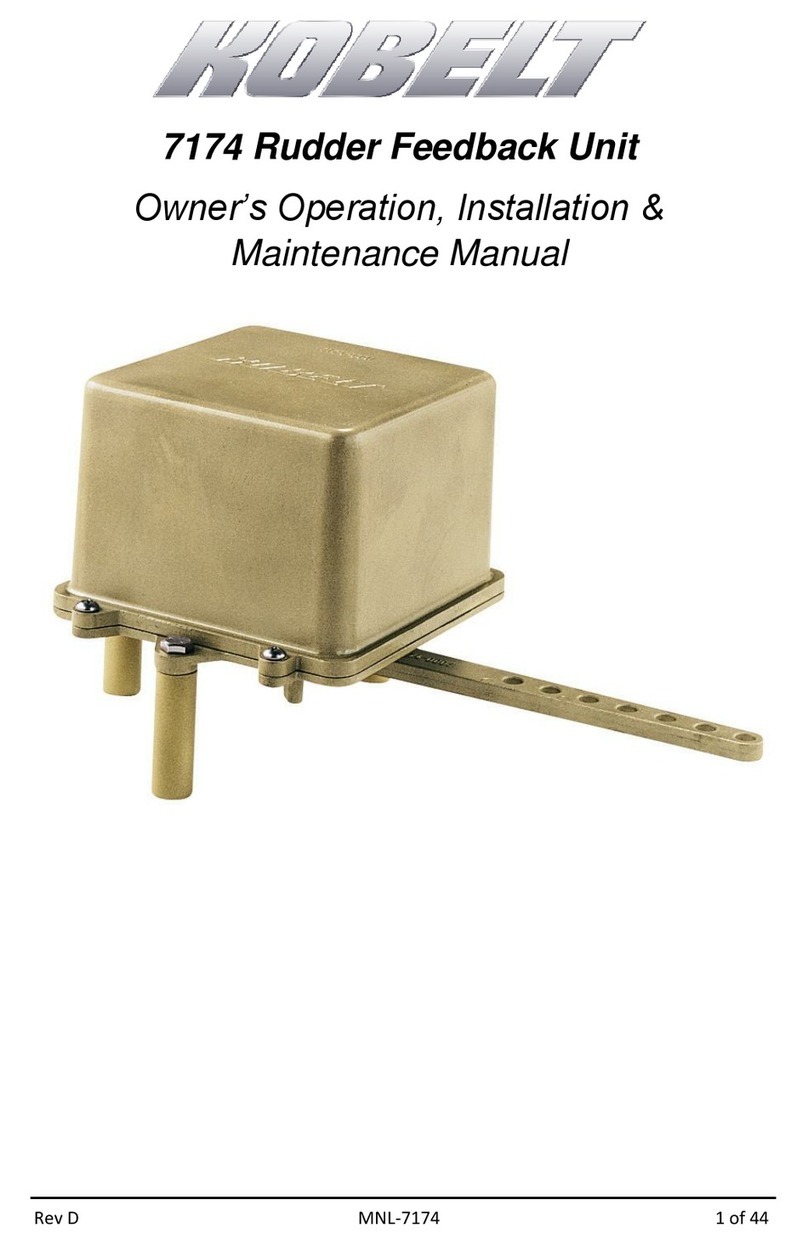
Kobelt
Kobelt 7174 Instruction Manual
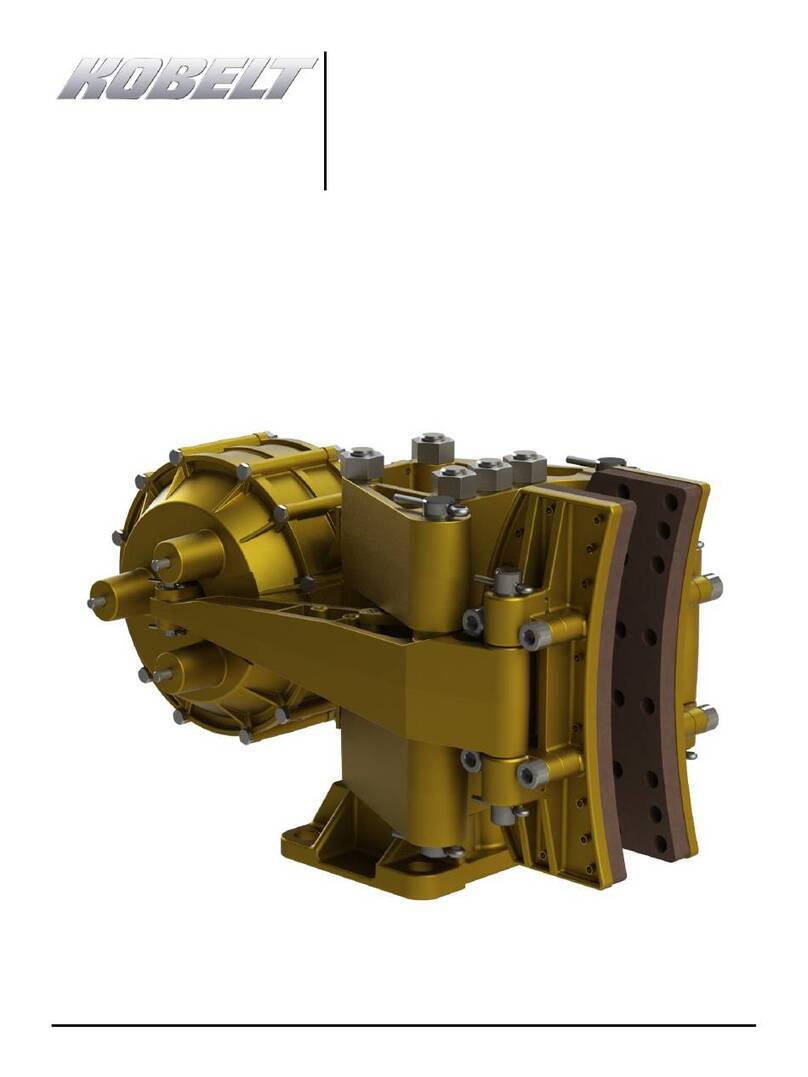
Kobelt
Kobelt 5024-A Instruction Manual
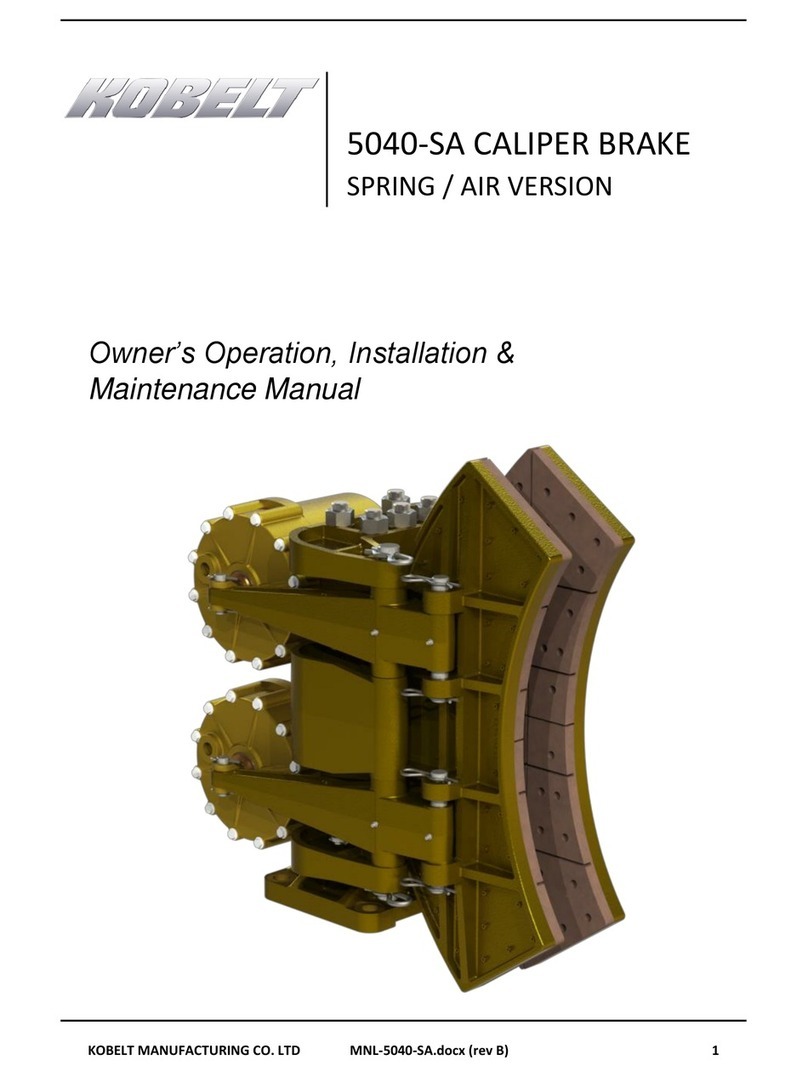
Kobelt
Kobelt 5040-SA Instruction Manual

Kobelt
Kobelt 2588 Instruction Manual
